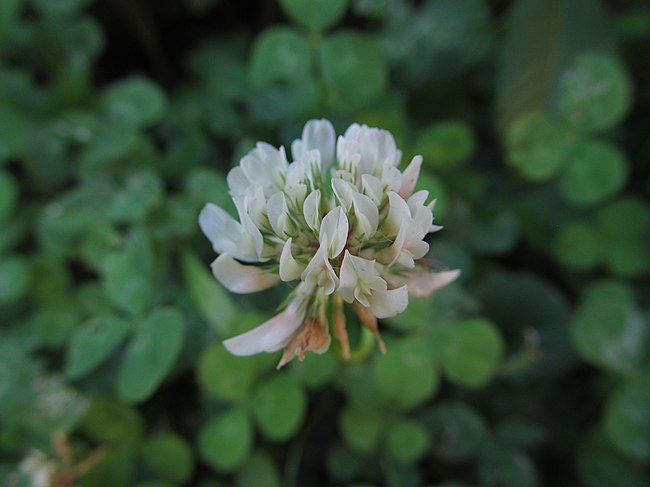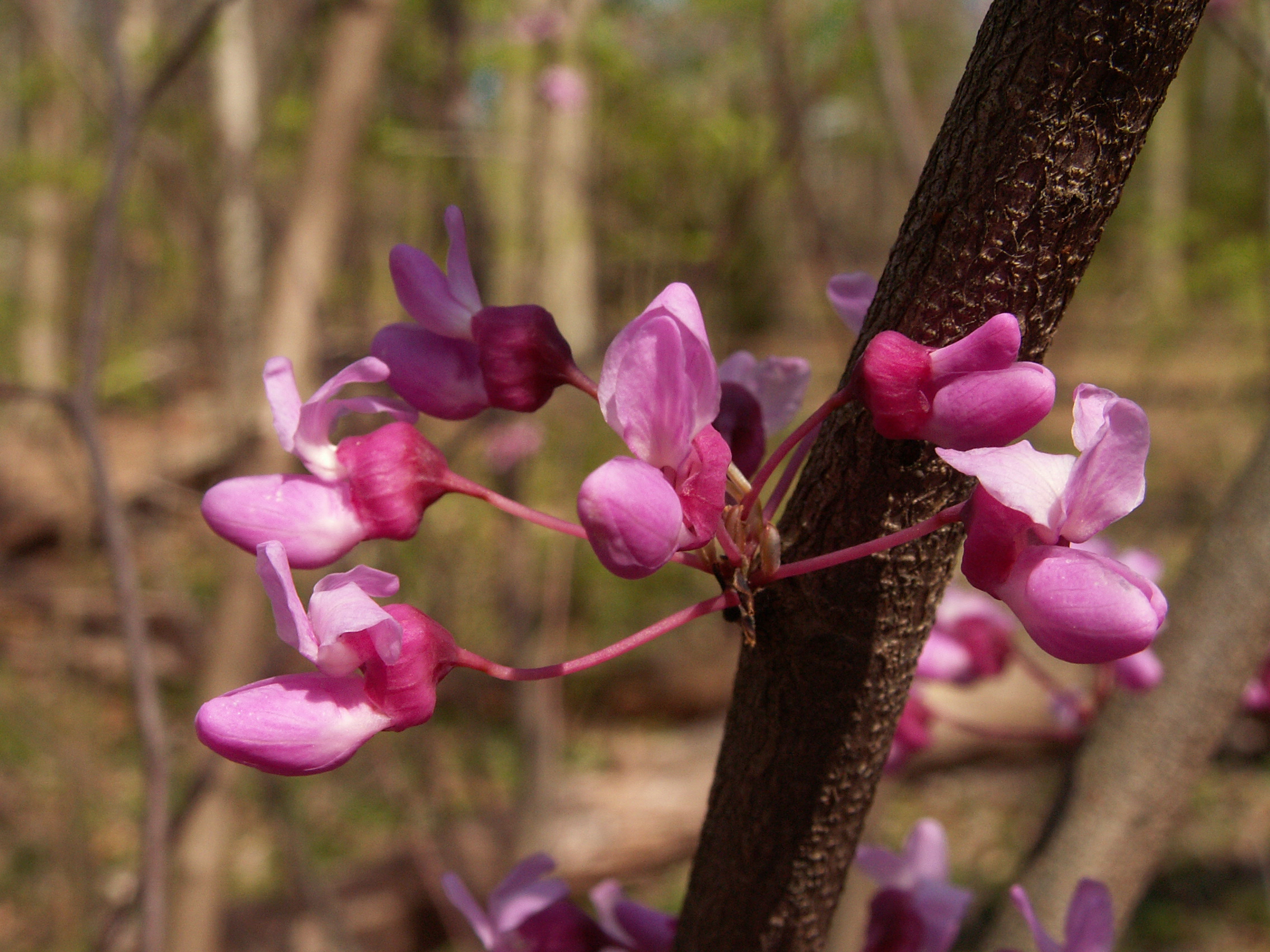
We last pictured this plant twelve years ago, so we repeat what we said then:
Tick-trefoils are mild annoyances to hikers and walkers, but this one is such a beautiful flower that we can easily forgive it. Like all the other tick-trefoils, it has transformed the ordinary legume of the pea family into a fabulously efficient instrument of dispersal. The pod is divided into individual segments that separate easily, and each of them is coated with sticky adhesive hairs. As you pass by the plant, several of those segments stick to your clothes and ride off with you, at least until you notice them. It may be quite a distance: since the seedpods are sticky rather than prickly, you tend not to notice them until you see them.
Other tick-trefoils have pretty but inconspicuous little flowers; this one, however, has larger flowers in a dense and showy raceme.

Flowers. Pink-purple, in dense branching raceme; the standard slightly paler.
Leaves. Dense on the stem; three leaflets arranged pinnately; lanceolate, entire; rough, especially beneath; on short petioles.
Stem. Somewhat sparse hairs; tough and inflexible.
Gray describes the genus and the species:
DESMÒDIUM Desv. TICK TREFOIL.
Calyx usually 2-lipped. Standard obovate; wings adherent to the straight or straightish and usually truncate keel, by means of a little transverse appendage on each side of the latter. Stamens diadelphous, 9 and 1, or monadelphous below. Pod flat, deeply lobed on the lower margin, separating into flat reticulated joints (mostly roughened with minute hooked hairs). — Perennial herbs, with pinnately 3-foliolate (rarely 1-foliolate) leaves, gtipellate. Flowers in axillary or terminal racemes, often panicled, and 2 or 8 from each bract, purple ol purplish, often turning green in withering. Stipules and bracts scale-like, often striate. (Name from desmos, a bond or chain, from the connected jointe of the pods.) Meibomia Adans.
Pod slightly if at all stalked in the calyx; racemes panicled.
Stipules small and inconspicuous, mostly deciduous; pods of few rounitsl or obliquely oval or sometimes roundish-rhomboidal joints 3-6 mm. long.
Stems erect; bracts before flowering conspicuous; racemes densely flowered.
*D. canadénse *(L.) DC. Stem hairy, 6-15 dm. high; leaflets oblonq-lanceolate or ovate-lanceolate, obtuse, with numerous straightish veins, much longer than the petiole, 3.7-7.5 сш. long; flowers showy, larger than in any of our other species, 8-12 mm. long. (Meibomia Ktze.) — Open woods and banks of streams, N.B. to N.C., L. Winnipeg, Kan., and Okla.

In How to Know the Wild Flowers (1920), Mrs. Dana gives us this description:
TICK-TREFOIL.
Desmodium Canadense. Pulse Family.
Stem.—Hairy; three to six feet high. Leaves.—Divided into three somewhat oblong leaflets. Flowers.—Papilionaceous; dull purplish-pink; growing in densely flowered racemes. Pod.—Flat ; deeply lobed on the lower margin; from one to three inches long; roughened with minute hooked hairs by means of which it adheres to animals and clothing.
Great masses of color are made by these flowers in the bogs and rich woods of midsummer. They are effective when seen in the distance, but rather disappointing on closer examination, and will hardly bear gathering or transportation. They are by far the largest and most showy of the genus….
Many of us who do not know these plants by name have uttered various imprecations against their roughened pods. Thoreau writes: ” Though you were running for your life, they would have time to catch and cling to your clothes….These almost invisible nets, as it were, are spread for us, and whole coveys of desmodium and bidens seeds steal transportation out of us. I have found myself often covered, as it were, with an imbricated coat of the brown desmodium seeds or a bristling chevaux-de-frise of beggar-ticks, and had to spend a quarter of an hour or more picking them off in some convenient spot; and so they get just what they wanted—deposited in another place.”
In her Nature’s Garden (1900), Neltje Blanchan meditates on the ability of such plants as this to disperse themselves far and wide, and gives us the fascinating details of this species’ pollination:
Canadian or Showy Tick-trefoil
(Meibomia Canadensis) Pea family
(Desmodium Canadense of Gray)
Flowers—Pinkish or bluish purple, butterfly-shaped, about 1/2-in. long, borne in dense, terminal, elongated racemes. Stem: Erect, hairy, leafy, 2 to 8 ft. high. Leaves: Compounded of 3 oblong leaflets, the central one largest; upper leaves nearly seated on stem; bracts, conspicuous before flowering, early falling off. Fruit: A flat pod, about 1 in. long, jointed, and covered with minute hooked bristles, the lower edge of pod scalloped; almost seated in calyx. Preferred Habitat—_Thickets, woods, river banks, bogs. _Flowering Season—July—September. Distribution—New Brunswick to Northwest Territory, south to North Carolina, westward to Indian Territory and Dakota.
As one travels hundreds or even thousands of miles in a comfortable railway carriage and sees the same flowers growing throughout the length and breadth of the area, one cannot but wonder how ever the plants manage to make the journey. We know some creep along the ground, or under it, a tortoise pace, but a winning one; that some send their offspring flying away from home, like dandelions and thistles; and many others with wings and darts are blown by the wind. Berries have their seeds dropped afar by birds. Aquatic plants and those that grow beside running water travel by river and flood. European species reach our shores among the ballast. Darwin raised over sixty wild plants from seed carried in a pellet of mud taken from the leg of a partridge. So on and so on. The imagination delights to picture these floral vagabonds, each with its own clever method of getting a fresh start in the world. But by none of these methods just mentioned do the tick-trefoils spread abroad. Theirs is indeed a by hook or by crook system. The scalloped, jointed pod, where the seeds lie concealed, has minute crooked bristles, which catch in the clothing of man or beast, so that every herd of sheep, every dog, every man, woman, or child who passes through a patch of trefoils gives them a lift. After a walk through the woods and lanes of late summer and autumn, one’s clothes reveal scores of tramps that have stolen a ride in the hope of being picked off and dropped amid better conditions in which to rear a family.
Only the largest bees can easily “explode” the showy tick-trefoil. A humblebee alights upon a flower, thrusts his head under the base of the standard petal, and forces apart the wing petals with his legs, in order to dislodge them from the standard, his motion causes the keel, also connected with the standard, to snap down violently, thus releasing the column within and sending upward an explosion of pollen on the under surface of the bee. Here we see the wing petals acting as triggers to discharge the flower. Depress them and up flies the fertilizing dust—once. The little gun will not “go off” twice. No nectar rewards the visitor, which usually is a pollen-collecting bee. The highly intelligent and important humblebee has tne advantage over his smaller kin in being able to discharge the pollen from both large and smaller flowers.











